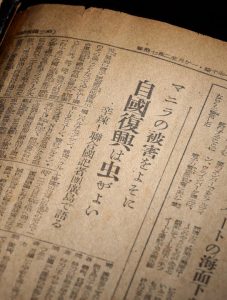Documenting Hiroshima of 1945: December 28, reporters from Allied nations visit Hiroshima to gather news
Dec. 28, 2024
by Kyosuke Mizukawa, Senior Staff Writer
On December 28, 1945, 10 reporters from newspapers and news agencies in such Allied nations as the United States, the United Kingdom, and the Republic of China visited Hiroshima City. The purpose of their visit, which had been mediated by the General Headquarters of the Allied Powers (GHQ), was to gather news about the situation in Hiroshima following the atomic bombing. After observing the condition of damages in the city, the reporters met with Hiroshima City Mayor Shichiro Kihara and top officials from the Hiroshima Prefectural government at a provisional prefectural government office building located on the grounds of Toyo Kogyo (present-day Mazda Motor Corporation), in Fuchu-cho, Hiroshima Prefecture.
On December 30, the Chugoku Shimbun reported in detail on the interactions that had taken place at that time. The Hiroshima representatives ardently demanded assistance because restoration efforts in the city were not proceeding as expected due to supply shortages. Asked about the support they sought from overseas, the representatives replied “machinery, construction materials, and provisions.”
Meanwhile, the reporters raised the issue of destruction caused by Japan in Asia during the war and questioned, if Japanese people had known about the war damages in Manila and then-Nanjing, they would not have been able to consider the recovery of their own nation without doing anything about the damages in the other nations.
In response, the Hiroshima representatives explained that, “Japanese people do not know anything of the damages in other nations because the government prohibited such reporting during the war.” When the reporters asked whether newspapers had carried photographs of such damages, the Hiroshima representatives replied, “No photos were carried during the war, and only just recently have they finally appeared little by little, surprising people as to the damages outside of Japan.” The article in the December 30 Chugoku Shimbun reported that the participants on the Hiroshima side “seemed very distressed.”
During the war, all Japanese newspapers, including the Chugoku Shimbun, adhered to the government’s press controls and communicated “Imperial Headquarters communiqués,” which skewed the actual status of the war with the aim of lifting the public’s will to continue fighting. Under the headline “Eradication of War,” an editorial in the Chugoku Shimbun dated December 25 recalled the situation in Japan during the war. “We lost sight of the profound and just recognition regarding the evil of war.” The article added that the country had just started to feel the deep pain and guilt of the war at its core, making the following appeal.
“Through this lesson, the new Japan must thoroughly recognize that war itself, regardless of victory or defeat, destroys human culture as well as people’s lives, and causes crimes; going forward, we must reform our own nation so that such a mistake is never made again.”
(Originally published on December 28, 2024)
On December 28, 1945, 10 reporters from newspapers and news agencies in such Allied nations as the United States, the United Kingdom, and the Republic of China visited Hiroshima City. The purpose of their visit, which had been mediated by the General Headquarters of the Allied Powers (GHQ), was to gather news about the situation in Hiroshima following the atomic bombing. After observing the condition of damages in the city, the reporters met with Hiroshima City Mayor Shichiro Kihara and top officials from the Hiroshima Prefectural government at a provisional prefectural government office building located on the grounds of Toyo Kogyo (present-day Mazda Motor Corporation), in Fuchu-cho, Hiroshima Prefecture.
On December 30, the Chugoku Shimbun reported in detail on the interactions that had taken place at that time. The Hiroshima representatives ardently demanded assistance because restoration efforts in the city were not proceeding as expected due to supply shortages. Asked about the support they sought from overseas, the representatives replied “machinery, construction materials, and provisions.”
Meanwhile, the reporters raised the issue of destruction caused by Japan in Asia during the war and questioned, if Japanese people had known about the war damages in Manila and then-Nanjing, they would not have been able to consider the recovery of their own nation without doing anything about the damages in the other nations.
In response, the Hiroshima representatives explained that, “Japanese people do not know anything of the damages in other nations because the government prohibited such reporting during the war.” When the reporters asked whether newspapers had carried photographs of such damages, the Hiroshima representatives replied, “No photos were carried during the war, and only just recently have they finally appeared little by little, surprising people as to the damages outside of Japan.” The article in the December 30 Chugoku Shimbun reported that the participants on the Hiroshima side “seemed very distressed.”
During the war, all Japanese newspapers, including the Chugoku Shimbun, adhered to the government’s press controls and communicated “Imperial Headquarters communiqués,” which skewed the actual status of the war with the aim of lifting the public’s will to continue fighting. Under the headline “Eradication of War,” an editorial in the Chugoku Shimbun dated December 25 recalled the situation in Japan during the war. “We lost sight of the profound and just recognition regarding the evil of war.” The article added that the country had just started to feel the deep pain and guilt of the war at its core, making the following appeal.
“Through this lesson, the new Japan must thoroughly recognize that war itself, regardless of victory or defeat, destroys human culture as well as people’s lives, and causes crimes; going forward, we must reform our own nation so that such a mistake is never made again.”
(Originally published on December 28, 2024)








